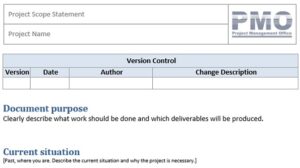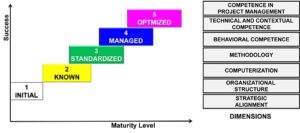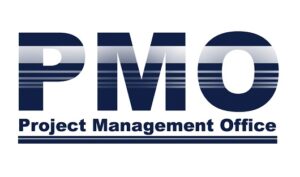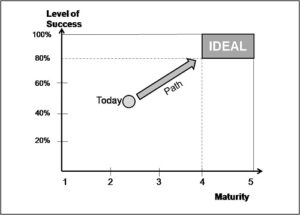In project management, success often depends less on how much you do and more on how precisely you define what truly matters. The Scope Performance Domain, introduced in the PMBOK® Guide – Eighth Edition (2025), captures this mindset by emphasizing that defining, validating, and controlling project scope is essential for delivering value-driven outcomes.
Unlike older editions, PMBOK 8 does not treat scope as a checklist of requirements. Instead, it views it as a performance domain — an integrated area of focus that interacts with governance, schedule, finance, and stakeholder domains to ensure alignment and value delivery. This article explores how the Scope Performance Domain works and how it reshapes the way project professionals manage boundaries, expectations, and change.
What Is the Scope Performance Domain?
According to the PMBOK® Guide – Eighth Edition, performance domains represent system components that collectively enable effective project delivery. The Scope Performance Domain defines the mechanisms through which project teams identify, validate, and deliver the work required to achieve intended outcomes.
Scope in PMBOK 8 is not limited to deliverables or requirements documentation; it’s about value alignment and understanding what will drive success and bring tangible benefits to stakeholders. Each activity within the domain ensures that:
- The project’s objectives are clearly defined and connected to organizational strategy.
- Work is continuously validated against stakeholder needs.
- Adjustments to scope reflect value changes, not administrative change control.
In essence, the Scope Performance Domain helps teams concentrate on what truly matters by establishing clear boundaries and expectations. It provides a framework for identifying what is included in the project and, equally importantly, what is not. By doing so, it helps to prevent scope creep, where additional features or tasks are added without proper evaluation or approval, often leading to project delays and increased costs.
By mastering the Scope Performance Domain, project managers can effectively navigate the complexities of project requirements and stakeholder expectations. This ensures that the teams efforts are focused on delivering value, optimizing resources, and achieving project objectives.
The Relationship Between Scope and Value
The central theme of PMBOK 8 is value delivery — and scope is its foundation. Without clarity on what value means to stakeholders, scope statements risk becoming static documents that don’t reflect evolving priorities.
Within this domain:
- Value drives scope definition. Before defining deliverables, teams must understand what success looks like from a business perspective and the value the deliverables add to the organization and its stakeholders.
- Stakeholders co-create the scope. Continuous feedback ensures that project work remains aligned with evolving expectations.
- Adaptation replaces rigidity. Change requests are evaluated based on their contribution to value, not merely adherence to initial plans.
This approach transforms scope from a “boundary control” concept into a dynamic value alignment mechanism.
Value is derived from how well the project outcomes meet the needs and expectations of stakeholders. Thus, the scope should be crafted with a clear vision of the desired value. This means that every element included in the project scope should directly contribute to achieving meaningful benefits. When scope aligns with value, resources are utilized efficiently, and project objectives are more likely to be met.
Moreover, maintaining a strong focus on value helps in prioritizing project elements and making informed decisions about what to include or exclude. This is especially crucial in dynamic environments where requirements might evolve. By consistently evaluating the connection between scope and value, teams can adapt and pivot as necessary, ensuring that the project’s ultimate benefits are realized.
Defining Scope
Clearly defining the project scope is a cornerstone of project success. Without a well-defined scope, projects can veer off course, leading to wasted resources and unmet objectives. A precise scope acts as a roadmap, guiding the project team and aligning stakeholders on the project’s goals and deliverables.
To effectively define the project scope, consider the following steps:
- Understand the problem or opportunity. Clarify why the project exists before specifying what will be done.
- Identify Objectives: Clearly articulate the project’s goals and what it aims to achieve.
- Translate objectives into outcomes. Focus on end results rather than task lists.
- Engage stakeholders early. Validation begins at initiation and continues throughout delivery.
- Gather Requirements: Engage stakeholders to understand their needs and expectations.
- Define Deliverables: Specify the tangible outputs that the project will produce.
- Create a Scope Statement: Document the project’s boundaries, including inclusions and exclusions.
- Validate with Stakeholders: Ensure that all stakeholders agree and understand the defined scope.
- Use visual tools. Product roadmaps, user stories, or context diagrams help align expectations.
- Establish clear acceptance criteria. These define how scope completion will be verified.
By following these steps, project teams can establish a solid foundation for scope management, enhancing the project’s chances of delivering true value. A well-defined scope not only provides clarity but also sets the stage for effective scope control throughout the project lifecycle.
Defining scope is not about locking down details but creating a shared understanding of what value looks like in practice.
Controlling Scope Without Killing Agility
Balancing scope control with agility can be a daunting challenge for project teams. The need to maintain flexibility often clashes with the necessity to keep projects on track. Uncontrolled scope changes can lead to scope creep, budget overruns, and missed deadlines. However, rigid control can stifle innovation and adaptability, essential elements in today’s fast-paced project environments.
The goal is to prevent uncontrolled expansion (scope creep) while maintaining flexibility to accommodate legitimate shifts in priorities. To effectively control scope without compromising agility, consider employing these techniques:
- Iterative Review or Validation cycles: Regularly revisit scope definitions and project priorities to ensure alignment with evolving project needs.
- Stakeholder Engagement: Maintain open lines of communication with stakeholders to quickly address potential scope changes and incorporate feedback.
- Transparent decision-making: All changes must be linked to measurable value.
- Collaborative Change Control: Implement streamlined processes where governance and stakeholders jointly evaluating and approving scope changes, ensuring they add value and align with project objectives.
- Prioritization Frameworks: Use prioritization techniques like MoSCoW or the Eisenhower Matrix to determine which scope elements are critical and which can be adjusted.
- Progressive elaboration: Scope details evolve as understanding improves.
By integrating these techniques, project teams can maintain the flexibility required for agile project management while ensuring that scope changes don’t derail project success. This balanced approach ensures that scope changes support — not hinder — value delivery.
Stakeholder Collaboration and Validation
Stakeholder participation lies at the heart of the Scope Performance Domain. PMBOK 8 promotes a model where scope is validated through continuous collaboration rather than one-time approvals.
Effective collaboration includes:
- Regular engagement sessions and demonstrations.
- Transparent progress reporting.
- Shared ownership of deliverables.
- Clear traceability between stakeholder expectations and project outcomes.
Validation becomes a shared responsibility, ensuring that value remains visible and measurable.
Tailoring the Scope Performance Domain
PMBOK 8 encourages tailoring — adapting practices to the project’s size, complexity, and culture. Tailoring the Scope Performance Domain involves adjusting how scope is defined, documented, and controlled.
Examples include:
| Context | Tailoring Example |
|---|---|
| Agile Project | Define scope through user stories and prioritize via a product backlog. The focus might be on flexibility and iterative scope definition. |
| Predictive Project | Use a detailed Work Breakdown Structure (WBS) and formal change control process. In highly regulated industries, additional compliance steps might be necessary. |
| Hybrid Project | Combine iterative definition with milestone-based approvals. |
Tailoring allows governance to remain light where flexibility is needed and structured where predictability is critical. This adaptability can lead to enhanced performance, greater stakeholder satisfaction, and a higher likelihood of project success.
Measuring Scope Performance
By using metrics to emphasize performance over compliance, organizations can evaluate how well their scope supports value creation.
Common Scope Performance Indicators (SPIs):
SPIs are metrics that help gauge how closely a project aligns with its defined scope. They provide a quantitative basis for tracking scope adherence and highlighting areas needing attention.
- Requirements Stability Index: Percentage of requirements that remain valid through execution.
- Change Impact Ratio: Number of approved changes versus total change requests.
- Deliverable Validation Rate: Percentage of deliverables accepted on first review.
- Value Realization Score: Degree to which completed work contributes to strategic objectives.
- Scope Creep Rate: This indicator measures the frequency and extent of changes to the project scope. A high scope creep rate can signal inadequate scope definition or lack of control.
- Scope Change Requests: Tracking the number and impact of scope change requests helps in understanding their effect on project timelines and costs.
- Scope Variance: This metric compares planned scope with actual deliverables, shedding light on deviations and their potential reasons.
By regularly monitoring these indicators, project managers can ensure that the project stays on track, delivering the intended value while minimizing disruptions. These metrics ensure that scope remains not only controlled but also relevant and beneficial.
Integrating Scope with Other Performance Domains
The Scope Performance Domain does not operate in isolation. It directly interacts with:
- Governance Performance Domain – for decision-making and approval structures.
- Schedule Performance Domain – to ensure work sequencing supports deliverables.
- Finance Performance Domain – to align resources and budget with approved scope.
- Stakeholder Performance Domain – for communication, validation, and engagement.
Understanding these interconnections helps project managers maintain a holistic view of performance — a fundamental PMBOK 8 principle.
FAQ on Scope Performance Domain
The Scope Performance Domain often raises questions and misconceptions. Here are answers to some of the most frequently asked questions to help clarify its role and importance:
Q1: Is scope management only about preventing scope creep?
A1: While preventing scope creep is crucial, scope management also involves defining, validating, and aligning scope with project goals. It’s about ensuring that the project delivers true value, not just staying on track.
Q2: How does scope performance relate to project success?
A2: A well-managed scope ensures that project outputs meet stakeholder expectations. This alignment is vital for project success, making scope performance a key indicator of whether a project will deliver its intended benefits.
Q3: Can scope be controlled without sacrificing agility?
A3: Yes, with adaptive scope management, teams can remain flexible. This approach allows for adjustments while maintaining control, balancing stability with the necessary adaptability to meet evolving needs.
Q4: What role do stakeholders play in scope validation?
A4: Stakeholders are essential in scope validation, as their feedback ensures the project aligns with their expectations. Engaging them throughout the process is crucial for validating and refining scope.
Understanding these aspects can help teams better navigate the complexities of the Scope Performance Domain, ultimately enhancing project outcomes and value delivery.
Conclusion
The Scope Performance Domain in PMBOK 8 moves beyond documentation and control to emphasize continuous value alignment. It challenges project professionals to think strategically, collaborate actively, and adapt constantly.
By mastering this domain, organizations can ensure that every project delivers precisely what matters — no more, no less — while remaining flexible enough to adapt to evolving priorities.
Ultimately, scope management is not about preventing change but about ensuring that change always adds value.
Now, it’s time to put these insights into action. Embrace these strategies in your projects and witness the transformation in how you define and control what truly matters. Start today and make scope management a driving force behind your project’s success!
Call to Action:
References
Project Management Institute (PMI). A Guide to the Project Management Body of Knowledge (PMBOK® Guide) – Eighth Edition. Newtown Square, Pennsylvania, USA: Project Management Institute, 2025. PMBOK Guide 8: The New Era of Value-Based Project Management. Available at: https://projectmanagement.com.br/pmbok-guide-8/
Disclaimer
This article is an independent educational interpretation of the PMBOK® Guide – Eighth Edition, developed for informational purposes by ProjectManagement.com.br. It does not reproduce or redistribute proprietary PMI content. All trademarks, including PMI, PMBOK, and Project Management Institute, are the property of the Project Management Institute, Inc. For access to the complete and official content, purchase the guide from Amazon or download it for free at https://www.pmi.org/standards/pmbok if you are a PMI member.





